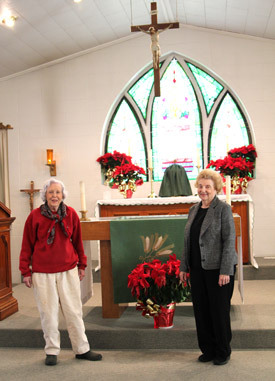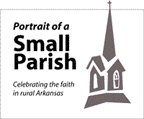

OSCEOLA -- The original wooden church no longer stands in Osceola, but the memory of its pioneer spirit still burns bright in the hearts of parishioners.
“It’s a wonderful little church, and we really take care of ourselves. If you’ve been brought up a Catholic, it’s home. Everybody would be devastated if we lost this church,” said Patty Butler who moved to Osceola in 1946 from Blytheville. “I don’t think it’s that way for everyone, but we’ve most always been a mission.”
Butler and Kate Schuncke, longtime parishioners and Altar Society members, consider St. Matthew home,
“I’ve been here all my life. As a little girl, I came to Mass here. This is our church home and we love it. And we have a lot of history here and a lot of people who were dedicated to this church,” Schuncke said. “And we’re dedicated to this church. All of us are real proud of this church.”
Before the church was built, priests came from Memphis on horseback to offer Mass at the home of Capt. Dan Matthews and Sammuel Spencer Semmes.
Semmes came to Osceola after the Civil War, during which he served as a major in the Confederate Army. He went on to establish the Bank of Osceola and serve as county judge.
Out of his 12 children, a son and two daughters entered religious orders -- Father Oliver Semmes, a Jesuit priest who served in Jamaica; Sister Mary DeSales (Myra Felicia Semmes), a Dominican sister who taught music at St. Cecilia Academy in Nashville, Tenn.; and Sister Ann Frances (Katherine “Kate” Semmes), a Dominican sister who also taught at St. Cecilia Academy.
Click here |
As the services grew in attendance, Mass was held in a schoolhouse until the Catholic community could raise funds and build a church on Broadway in what is now called “Old Town.”
A yellow fever epidemic in 1879 brought two carpenters from Memphis, who, like many others, came to Osceola to escape the illness in the city. They offered to build the church in exchange for money for food and living expenses.
The original wooden church with an alcove stood across from the levee. Soon after it was built, a cyclone blew through and shifted its foundation, the church stood slightly crooked ever since
Emma Cox, owner of the movie theaters in town and parishioner at St. Matthew, left a portion of her estate to the church. This bequest allowed them to buy land for a planned new church in 1962.
Parishioners saved as much as possible from the historic church, including the altar, stained glass windows and iron gates that Cox purchased to grace the alcove.
“It was a sweet little church too,” Schuncke said. “I loved that church. We just couldn’t stay there anymore.”
The original St. Matthew Church was up for the historic register, but not in time to save it from demolition. Ironically, it was a non-Catholic who sent the request into the Arkansas Legislature.
“They tore it all the way down. The nails were square,” Schuncke said. “I stood and watched it for awhile. The tears came down my face and I couldn’t stand it any longer. I left.”
Schuncke was responsible for coordinating the effort to move and restore the windows, raising funds for a stained glass company from Memphis to restore and install the windows in the church.
“We’re crazy about them,” Schuncke said. “We love having them here. It’s our history.”
A larger church and education building was completed in 1971. Bishop Albert L. Fletcher dedicated the new St. Matthew Church in April 1972.
With about 57 Catholic families in the Delta area, a small community is something parishioners at St. Matthew live with every day.
“We’re in a community where most everybody is Protestant,” Schuncke said. “We’re the only Catholics around here.”
“We’re swimming in Baptist waters,” Butler replied.
“And they watch everything we do and take it in, and you have to really march the straight line. We’re really proud of our little church,” Schuncke said.
At one time, the parish had a basketball team in the church league -- mostly comprised of two families, the Butlers and the Holthouses.
“They were really good basketball players. They beat all the churches. No matter how good they were, we were better. There were these signs up -- ‘Beat the Catholics.’ They decided to disband the league and they didn’t get to play anymore.”
Without the participation of parishioners, St. Matthew wouldn’t have remained a mainstay in the Delta community along the Mississippi River.
“If we didn’t have people who volunteered, we wouldn’t be here,” Schuncke said.
It took perseverance from the early settlers to establish the church in Osceola, and dedication from current parishioners to keep it going into the future.
“We’re all close here. Everybody’s friendly and fun,” Butler said. “We’re lucky that we’ve had good members. You have a lot of people who did a lot of things that need to be done.”
What drove the settlers to found St. Matthew Church is the same love of their Catholic faith that has current parishioners returning.
“It’s home. We love this church. It has a lot of good memories,” Schuncke said. “It means everything to have a church here, everything.”
Please read our Comments Policy before posting.
Article comments powered by Disqus Planned Parenthood’s report shows increase in abortions
Planned Parenthood’s report shows increase in abortions
 Don’t let misconceptions cause faith to waver
Don’t let misconceptions cause faith to waver
 Seniors, whatever storms may come, Jesus will be there
Seniors, whatever storms may come, Jesus will be there
 Studio 3:16 offers new approach to teaching religion
Studio 3:16 offers new approach to teaching religion
 After three decades, NLR principal plans to retire
After three decades, NLR principal plans to retire
 St. Joseph a model of solidarity with immigrants
St. Joseph a model of solidarity with immigrants
 Two gifts after Jesus’ death: Virgin Mary and Eucharist
Two gifts after Jesus’ death: Virgin Mary and Eucharist
 Why we have an altar, and not just a communion table
Why we have an altar, and not just a communion table
 Pope: Wars should be resolved through nonviolence
Pope: Wars should be resolved through nonviolence
 Living relationship with Jesus Christ in the Eucharist
Living relationship with Jesus Christ in the Eucharist